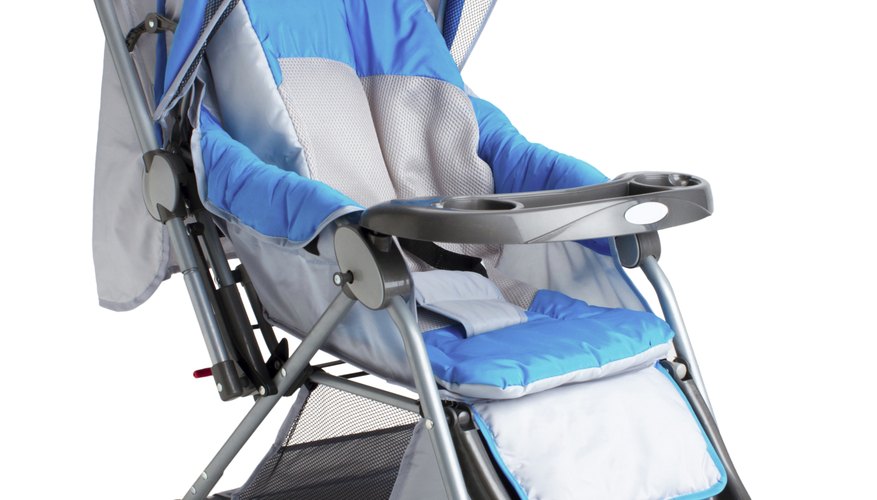There are two main types of wheels on a stroller -- air-filled (also called pneumatic) and non-air filled tyres.
Air-filled tyres are like those you'd find on a bike or a car; they are typically made from rubber, require a certain amount of air to inflate and require periodic repairs.
Non-air filled tyres are typically made from plastic, and are often more durable. It is possible to make repairs and changes to both types of tires.
Pneumatic tyres
Check to see if there is enough air in the tyre. The owner's manual for your stroller should have information on the ideal pressure for the front and rear tyres. Use an air pressure gauge to see if the tyre is inflated properly. Remove excess air, or use an air pump to get more air.
See if the tyre is holding the air in the tyre. If you see the tyre deflate, you probably have a problem with the tyre itself.
Check the tyre's surface for any visible holes. You may notice a "hissing" sound coming from any leaks.
Use a tyre patch kit to cover up and repair any leaks. Make sure the patch kit is compatible with your model of stroller. Follow the directions on the repair kit you purchase.
Replace the tyre entirely if the patch does not work, or if you are unable to find any leaks. Remove the old tyre using your hands; you may need a screwdriver or set of pliers to help remove the tyre from its track. Place the new tyre on the track. Make sure no part of the new tyre hangs over; use the screwdriver to ensure the lip of the tyre is securely in place.
Consider replacing the entire wheel if none of the above steps work. This can actually be easier than simply replacing a tyre. Read your owner's manual to see what size of wheel you need. Go to the shop where you originally bought the stroller to buy a replacement wheel, or contact the manufacturer directly, as some parts may be under warranty. Remove the old wheel by using a spanner to loosen the bolts. Insert the new wheel, and tighten the bolts back in place. If the bolts are worn, consider replacing them as well.
- Check to see if there is enough air in the tyre.
- Place the new tyre on the track.
- Go to the shop where you originally bought the stroller to buy a replacement wheel, or contact the manufacturer directly, as some parts may be under warranty.
Solid tyre
Check to see which tyre is giving you problems. Inspect the wheel for any visible problems, such as dents, things stuck in the tyre or problems with the alignment. Remove any debris that may be causing the issue, then see if your stroller works better.
Grease the wheels using WD-40 or another type of lubricant to make them roll more smoothly.
Contact the manufacturer if problems persist. Depending on the age of your stroller, it may be under warranty, and the company may be responsible for any significant repairs.
- Check to see which tyre is giving you problems.
- Depending on the age of your stroller, it may be under warranty, and the company may be responsible for any significant repairs.
Read the owner's manual to see what type of wheel the stroller takes. Unlike air-filled tyres, non-air filled wheels typically do not have separate tyres and wheels. If you choose to replace anything, you will have to replace the entire wheel.
Replace the wheel following the directions in your owner's manual. This step will vary depending on the make and model of your stroller. Generally, you will need a spanner or screwdriver to remove the old wheel and install the new one.
TIP
Consider taking your stroller to a repair shop. Even though this will cost you more than doing it yourself, it can guarantee the repairs are made correctly. If you buy the parts, a repair shop can make the fixes for just the cost of labour.
WARNING
Do not use a stroller with a broken or misaligned wheel. This can cause you to lose control of the stroller, putting the child inside of it in danger of injury. Unless otherwise instructed by the product manufacturer, do not use a replacement tyre or wheel that is not designed for your stroller.
